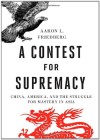Written by: Aaron L Friedberg
WW Norton & Company, New York,
2011, ISBN 9780393068283, 360pp,
Reviewed by: Dr Michael Lankowski, Strategic Policy Division, Department of Defence
The relationship between China and the United States is crucial to our region’s strategic stability and a central concern in Australian defence and security policy debates. In A Contest for Supremacy, Professor Aaron Friedberg provides a broad assessment of the Sino-US relationship, highlighting the growing risks for the United States as a result of China’s growing power, and sets out policy recommendations to strengthen US posture and influence in the Asia-Pacific. The book’s title neatly communicates its key message, that increasingly intense strategic rivalry is emerging between China and the United States, and that China’s rise poses a fundamental challenge to US primacy and national interests in Asia. Indeed, Friedberg warns that ‘if current trends continue, we are on track to lose our geopolitical contest with China’ (p. 6).
Friedberg assesses seven factors that shape the Sino-US relationship, arguing that the two most divisive factors—the narrowing power gap between the United States and China, and the differences in their political systems and values—are also likely to become the most decisive (pp. 37–38). He observes the sobering historical likelihood for changing power relativities to result in conflict between great powers, and convincingly argues that Sino-US strategic competition has deep roots that cannot simply be attributed to misperceptions or policy errors. The book acknowledges other more stabilising factors including economic interdependence, China’s integration into international institutions and nuclear deterrence, but judges that they can only constrain Sino-US rivalry rather than reverse it. For Friedberg, only the emergence of liberal democracy in China can lead to ‘stable and lasting peace’.
The second part of the book provides a concise overview of the relationship’s evolution from 1949 to 2010 and the emergence of a US policy consensus under the Clinton, Bush and Obama administrations—a combination of engagement and containment which Friedberg awkwardly labels as ‘congagement’. It then assesses Chinese strategic policy and intentions, outlining China’s cautious but steady approach to pursuing regional preponderance in Asia. This cogent assessment is supported by a useful appendix listing Chinese sources and authors.
The last chapters assess the changing balance of power and influence between the United States and China, including Friedberg’s perspective on Australia’s response to China’s rise (pp. 207–09), before setting out policy recommendations. Friedberg—a neo-conservative who served as Deputy Assistant for National Security Affairs to Vice President Dick Cheney—critiques US policy for being too heavily weighted towards engagement. He is especially critical of what he perceives as a ‘Shanghai Coalition’ of American businessmen, politicians, officials and academics that is too eager to please China at the expense of US interests (pp. 197–99). Friedberg is not only sceptical about the policy prescriptions of liberals, but also ‘so-called realists’ who do not share his emphasis on promoting US values. The book concludes by advocating steps to strengthen US balancing against China, through its regional military posture, alliances and diplomacy.
A number of these steps have been taken by the Obama Administration over the last few years, as part of the US ‘pivot’ or ‘rebalancing’ to the Asia-Pacific that has become even more explicit since A Contest for Supremacy was written. These developments highlight both strengths and weaknesses of the book. Friedberg is convincing in his assessment of fundamental geopolitical divergences driving intensifying strategic competition between China and the United States. Many of his conclusions and recommendations about US strategy towards China are prudent, well supported by balanced analysis and being implemented by US policy-makers.
Yet recent developments also undermine Friedberg’s more excessive criticisms of US policy and the alleged ‘Shanghai Coalition’. His vehemence often seems to reflect frustration with debates during the 1990s rather than a balanced depiction of current US policy trends. Similarly, a number of specific judgements are questionable; for example, Friedberg’s depiction of US entry to the East Asia Summit as a concession to China (pp. 169–70) or his enthusiasm for a US-led ‘community of Asian democracies’ to promote liberty throughout the region (pp. 281–82).
Overall, I found A Contest for Supremacy to provide an excellent realpolitik assessment of the Sino-US relationship, while being less convincing in some of its arguments and policy advocacy. It should be read by anyone interested in Asia-Pacific strategic affairs, and Australian readers will find it particularly useful to compare with Hugh White’s ‘Power Shift’ essay from 2010.

